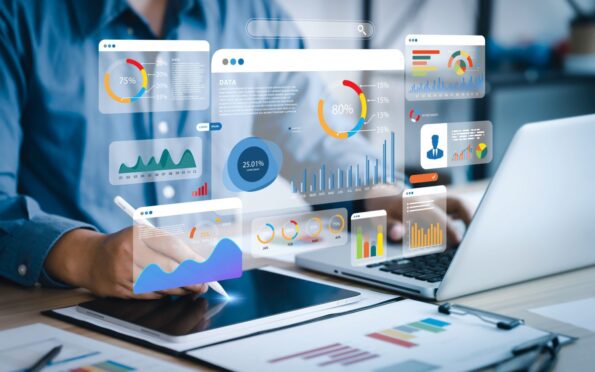Collecting the right data and analysing it effectively could be the key to long-term business success, especially when it comes to finances and accounting.
-
Some Press and Journal online content is funded by outside parties. The revenue from this helps to sustain our independent news gathering. You will always know if you are reading paid-for material as it will be clearly labelled as “Partnership” on the site and on social media channels.
This can take two different forms.
“Presented by”
This means the content has been paid for and produced by the named advertiser.
“In partnership with”
This means the content has been paid for and approved by the named advertiser but written and edited by our own commercial content team.
That’s essentially what Business Intelligence (BI) means – using information for decision making – and it’s not a new concept.
And yet, there are still lots of businesses that aren’t quite taking full advantage of everything BI can offer.
Aaron Geddes, senior insights specialist at Hutcheon Mearns, is keen to help change this.
After training as an accountant at a Big Four firm, he realised there was an opportunity to combine accounting and data science skillsets. So, after finishing his Chartered Accountant training contract in 2020, he undertook an MSc in Data Science.
He now helps businesses across Scotland improve their performance with the help of accounting data.
How Business Intelligence has evolved over the years
This, in theory, should be easier than ever to do thanks to the digitisation of business intelligence.
Aaron explained: “We used to process the information internally and we called it ‘experience’ or ‘intuition’.
“Over their careers, people would develop a sense of what decisions could drive specific outcomes based on past experience, knowledge of their industry, or knowledge of their customers. The best decision makers were the people who could apply all this information appropriately to the current problem.
“So, while they were not looking at data or analysis in the way that we often associate with modern business intelligence, they were still processing information to inform their decisions.”
Business Intelligence tools and technologies
Today, there are many tools and technologies to help businesses do this.
This all started in the 1970s which the introduction of relational databases, explains Aaron. These allowed data to be stored in a tabular format, i.e. rows and columns.
It made it easier to obtain key metrics, like sales totals and averages, to help with decision making.
Aaron said: “Businesses, including some that would go on to become some of the largest companies in the world, started using coding languages to apply statistical analysis to the transactions that would not only give them basic information, like averages, but would allow them to understand the distribution of the data.
“This could be used alongside other statistical techniques to provide predictive data that was extremely effective at informing decision makers. Anyone who could interpret statistics could now plan more effectively.”
At the same time, new tools and techniques also allowed for information and data to be presented in a much more user-friendly way. One of the most recent and popular examples of this is Microsoft Power BI, a market-leading business intelligence platform which features intuitive visualisation tools to create interactive dashboards and reports.
Applying Business Intelligence principles to accounting data
As a Chartered Accountant working for financial services business Hutcheon Mearns, Aaron is particularly interested in the crossover between accounting and data analytics, a still relatively uncommon skillset.
He explained: “While the above techniques have mostly been possible for decades, it is a minority of businesses that have implemented them successfully – and even fewer have implemented them successfully with finance and accounting data due to the specialised way it has to be processed.
“Some of the businesses that did successfully implement these techniques have grown from start ups to the largest companies in the world in the last 20 years.”
However, across Scotland, many businesses are still relying on the likes of Microsoft Excel providing tabular data and simple metrics.
Aaron said: “Classic reports such as management accounts remain the primary source of financial information. These reports are generally limited in the predictive information they provide, as well as being time-consuming to produce.”
Specialising in accounting and finance Business Intelligence
Hutcheon Mearns can specialise in providing accounting and finance data quickly because the Insights department – including Aaron – have unique knowledge of both accounting rules and data science principles.
They help clients automate the production of their old reports, produce more informative analytics and guide the client on how to interpret the analysis. This lets their clients spend less time preparing the information and allows them to make quicker and more informed decisions than before.
Some of the areas that the Hutcheon Mearns Insights team can make an impact include:
- Month-end management accounts automation
- Customer Performance Analytics
- Asset/Product Performance Analytics
- Credit control reporting
- Daily sales reporting
The Hutcheon Mearns Insights team is so successful at this work, it has recently been nominated for the Digital Innovation category at the Dundee & Angus Chamber Champion awards.
Is AI the future for Business Intelligence?
So what’s next? Artificial Intelligence (AI) is often discussed as the next big change set to transform everything, including Business Intelligence.
But Aaron thinks what’s more valuable for many businesses today is really learning how to use the data and data tools we have now.
He said: “There are businesses on the cutting edge, like OpenAI and Amazon, that will start doing amazing things with AI. But many businesses in Scotland would make huge improvements in performance if they started incorporating statistical techniques into their analysis.
“This includes businesses that maybe rely on simpler metrics like totals and averages, or rely exclusively on Excel reports that can’t visualise the information in a suitable way.
“Going from that to applying predictive statistics on business performance and presenting the information in an accessible format for decision making will significantly improve their performance, and it’s more realistic to implement successfully.
“Using older techniques well, like statistical analysis or data mining, will always serve you better than using advanced AI techniques without the proper knowledge to understand what they are doing.”
However, Aaron and Hutcheon Mearns as a whole see the demand for a crossover of accounting and BI skillsets becoming even more important in the finance industry.
That’s why they’re sponsoring a ‘Best in Year’ award for the recently created Accounting with Data Science degree at Robert Gordon University, to help support and champion the next generation of finance data specialists.
Ready to transform your decision making with Business Intelligence? Find out more about how the Hutcheon Mearns Insights team can help you use your accounting data more successfully.


